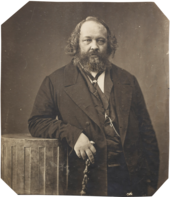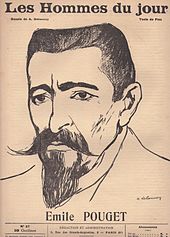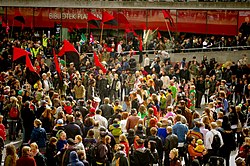Theory of direct working class or trade union power, founded in the theories of French social philosopher Georges Sorel (1847-1922).
Since political power arises from economic power, capitalism is most effectively replaced by workers organizing on the basis of their occupation or workplace, and then using their economic power either through strikes or occupations. A popular movement in Italy, particularly under Benito Mussolini (1883-1945).
Also see: industrial democracy, collective bargaining theory
Source:
G Sorel, Reflections on Violence (New York, 1941);
David Miller et al., eds, The Blackwell Encyclopaedia of Political Thought (Oxford, 1987)
Terminology
The term syndicalism has French origins. In French, a syndicat is a trade union, usually a local union. The corresponding words in Spanish and Portuguese, sindicato, and Italian, sindacato, are similar. By extension, the French syndicalisme refers to trade unionism in general.[2] The concept syndicalisme révolutionnaire or revolutionary syndicalism emerged in French socialist journals in 1903[3] and the French General Confederation of Labor (Confédération générale du travail, CGT) came to use the term to describe its brand of unionism. Revolutionary syndicalism, or more commonly syndicalism with the revolutionary implied, was then adapted to a number of languages by unionists following the French model.[4][note 1]
Many scholars, including Ralph Darlington, Marcel van der Linden, and Wayne Thorpe, apply the term syndicalism to a number of organizations or currents within the labor movement that did not identify as syndicalist. They apply the label to one big unionists or industrial unionists in North America and Australia, Larkinists in Ireland, and groups that identify as revolutionary industrialists, revolutionary unionists, anarcho-syndicalists, or councilists. This includes the Industrial Workers of the World (IWW) in the United States, for example, which claimed its industrial unionism was “a higher type of revolutionary labor organization than that proposed by the syndicalists”. Van der Linden and Thorpe use syndicalism to refer to “all revolutionary, direct-actionist organizations”. Darlington proposes that syndicalism be defined as “revolutionary trade unionism”.[note 2] He and van der Linden argue that it is justified to group together such a wide range of organizations because their similar modes of action or practice outweigh their ideological differences.[7]
Others, like Larry Peterson and Erik Olssen, disagree with this broad definition. According to Olssen, this understanding has a “tendency to blur the distinctions between industrial unionism, syndicalism, and revolutionary socialism”.[8] Peterson gives a more restrictive definition of syndicalism based on five criteria:
- A preference for federalism over centralism.
- Opposition to political parties.
- Seeing the general strike as the supreme revolutionary weapon.
- Favoring the replacement of the state by “a federal, economic organization of society”.
- Seeing unions as the basic building blocks of a post-capitalist society.
This definition excludes the IWW and the Canadian One Big Union (OBU). Peterson proposes the broader category revolutionary industrial unionism to encompass syndicalism, groups like the IWW and the OBU, and others. The defining commonality between these groups is that they sought to unite all workers in a general organization.[9]
Emergence
Rise

Mikhail Bakunin, an anarchist whom syndicalists viewed as an intellectual forerunner
Syndicalism originated in France and spread from there. The French CGT was the model and inspiration for syndicalist groups throughout Europe and the world.[10] Revolutionary industrial unionism, part of syndicalism in the broader sense, originated with the IWW in the United States and then caught on in other countries.[11] In a number of countries, however, certain syndicalist practices and ideas predate the coining of the term in France or the founding of the IWW. In Bert Altena’s view, a number of movements in Europe can be called syndicalist, even before 1900. According to the English social historian E.P. Thompson and the anarcho-syndicalist theorist Rudolf Rocker, there were syndicalist tendencies in Britain’s labor movement as early as the 1830s.[12] Syndicalists saw themselves as the heirs of the First International, the international socialist organization formed in 1864, particularly its anti-authoritarian wing led by Mikhail Bakunin. Bakunin and his followers advocated the general strike, rejected electoral politics, and anticipated workers’ organizations replacing rule by the state.[13] According to Lucien van der Walt, the Spanish section of the First International, formed in 1870, was in fact syndicalist.[14] Kenyon Zimmer sees a “proto-syndicalism” in the influence the anarchist-led International Working People’s Association (IWPA) and Central Labor Union, which originated in the American section of the First International, had in the Chicago labor movement of the 1880s. They were involved in the nationwide struggle for an eight-hour day. On May 3, 1886, the police killed three striking workers at a demonstration in Chicago. Seven policemen and four workers were killed the following day when someone, possibly a police member, threw a bomb into the crowd. Four anarchists were eventually executed for allegedly conspiring to the events. The Haymarket Affair, as these events become known, led anarchists and labor organizers, including syndicalists, in both the United States and Europe to re-evaluate the revolutionary meaning of the general strike.[15]
According to Émile Pouget, a French anarchist and CGT leader, from “the United States, the idea of the general strike – fertilized by the blood of anarchists hanged in Chicago […] – was imported to France”.[16] In the 1890s, French anarchists, conceding that individual action such as assassinations had failed, turned their focus to the labor movement. They were able to gain influence, particularly in the bourses du travail, which served as labor exchanges, meeting places for unions, and trades councils and organized in a national federation in 1893.[17] In 1895, the CGT was formed as a rival to the bourses, but was at first much weaker. From the start, it advocated the general strike and aimed to unite all workers. Pouget, who was active in the CGT, supported the use of sabotage and direct action. In 1902, the bourses merged into the CGT.[18] In 1906, the federation adopted the Charter of Amiens, which reaffirmed the CGT’s independence from party politics and fixed the goal of uniting all French workers.[19]
In 1905, the Industrial Workers of the World were formed in the United States by the Western Federation of Miners, the American Labor Union, and a broad coalition of socialists, anarchists, and labor unionists. Its base was mostly in the Western US where labor conflicts were most violent and workers therefore radicalized.[20] Although Wobblies insisted their union was a distinctly American form of labor organization and not an import of European syndicalism, the IWW was syndicalist in the broader sense of the word. According to Melvyn Dubofsky and most other IWW historians, the IWW’s industrial unionism was the specifically American form of syndicalism.[21] Nevertheless, the IWW also had a presence in Canada and Mexico nearly from its inception, as the US economy and labor force was intertwined with those countries.[22]

French syndicalist leader Émile Pouget
French syndicalism and American industrial unionism influenced the rise of syndicalism elsewhere.[23] Syndicalist movements and organizations in a number of countries were established by activists who had spent time in France. Ervin Szabó visited Paris in 1904 and then established a Syndicalist Propaganda Group in his native Hungary in 1910. Several of the founders of the Spanish CNT had visited France. Alceste de Ambris and Armando Borghi, both leaders in Italy’s USI, were in Paris for a few months from 1910 to 1911. French influence also spread through publications. Emile Pouget’s pamphlets could be read in Italian, Spanish, Portuguese, English, German, and Swedish translations. Journals and newspapers in a number of countries advocated syndicalism. For example, L’Action directe, a journal mainly for miners in Charleroi, Belgium, urged its readers to follow “the example of our confederated friends of France”.[24] The IWW’s newspapers published articles on French syndicalism, particularly the tactic of sabotage and the CGT’s La Vie Ouvrière carried articles about Britain’s labor movement by the British syndicalist Tom Mann.[25] Migration played a key role in spreading syndicalist ideas. The Argentine Regional Workers’ Federation (Federación Obrera Regional Argentina, FORA), openly anarchist by 1905, was formed by Italian and Spanish immigrants in 1901.[26] Many IWW leaders were European immigrants, including Edmondo Rossoni who moved between the United States and Italy and was active in both the IWW and USI.[27] International work processes also contributed to the diffusion of syndicalism. For example, sailors helped establish IWW presences in port cities around the world.[28]
Syndicalists formed different kinds of organizations. Some, like the French radicals, worked within existing unions to infuse them with their revolutionary spirit. Some found existing unions entirely unsuitable and built federations of their own, a strategy known as dual unionism. American syndicalists formed the IWW, though William Z. Foster later abandoned the IWW after a trip to France and set up the Syndicalist League of North America (SLNA), which sought to radicalize the established American Federation of Labor (AFL). In Ireland, the ITGWU broke away from a more moderate, and British-based, union. In Italy and Spain, syndicalists initially worked within the established union confederations before breaking away and forming USI and the CNT respectively.[29] In Norway, there were both the Norwegian Trade Union Opposition (Norske Fagopposition, NFO), syndicalists working within the mainstream Norwegian Confederation of Trade Unions (Landsorganisasjonen i Norge in Norwegian, LO), and the Norwegian Syndicalist Federation (Norsk Syndikalistik Federation in Norwegian, NSF), an independent syndicalist organization set up by the Swedish SAC.[30] In Britain, there was a similar conflict between ISEL and the local IWW organization.[31]
By 1914, there were syndicalist national labor confederations in Peru,[32] Brazil,[33] Argentina,[34] Mexico,[35] the Netherlands, Germany, Sweden, Spain, Italy, and France, while Belgian syndicalists were in the process of forming one.[36] There were also groups advocating syndicalism in Russia,[37] Japan,[38] the United States,[39] Portugal, Norway, Denmark, Hungary, and Great Britain.[40] Outside of North America, the IWW also had organizations in Australia,[41] New Zealand, where it was part of the Federation of Labour (FOL),[42] Great Britain, though its membership had imploded by 1913,[43] and South Africa.[44] In Ireland, syndicalism took the form of the ITGWU, which espoused a mix of industrial unionism and socialist republicanism, and was labeled Larkinism.[45]
Reasons
Scholars have given several explanations for the emergence of syndicalism. Werner Sombart, a German economist and sociologist, commenting in 1905, ascribes the rise of syndicalism to the Italian and particularly the French mentality. He writes: “The only people who could possibly act up to such a system of teaching are Frenchmen and Italians. They are generally men who do things impulsively […], who are seized upon by a sudden passionate enthusiasm […], but they have little application, perseverance, calm or steadiness.”[46]

Syndicalist mayday in Stockholm, 2010
There was a significant uptick in workers’ radicalism in most developed capitalist countries from 1911 to 1922, though it relented during World War I. Strikes increased in frequency, numbers of workers involved, and duration. According to van der Linden and Thorpe, syndicalism was only one way this radicalization expressed itself.[47] In the United Kingdom, for example, the period from 1910 to 1914 became known as the Great Labour Unrest. Many historians see syndicalism as a consequence of this unrest, but Elie Halévy and the politician Lord Robert Cecil claim it was its cause. Employers in France likewise blamed an upsurge in workers’ militancy in the same period on syndicalist leaders.[48] Syndicalism was further encouraged by employers’ hostility to workers’ actions.[49] The economist Ernesto Screpanti hypothesized that strike waves such as the one from 1911 to 1922 generally occur during the upper turning-points of the periodic global long cycles of boom and bust known as Kondratieff waves. Such waves of proletarian insurgency, claims Screpanti, were global in reach, saw workers breaking free of the dynamics of the capitalist system, and aimed to overthrow that system.[50]
According to van der Linden and Thorpe, workers’ radicalization manifested itself in their rejection of the dominant strategies in the, mostly socialist, labor movement, which was led by reformist trade unions and socialist parties. Lenin posited that “revolutionary syndicalism in many countries was a direct and inevitable result of opportunism, reformism and parliamentary cretinism.” A feeling that ideological disputes were draining workers’ power led Dutch, French, and American syndicalist organizations to declare themselves independent of any political groups. In countries like Italy, Spain, and Ireland, which was still under British rule, parliamentary politics were not seen as a serious means for workers to express their grievances. Most workers were disenfranchised. Yet even in France or Britain, where most male workers had the right to vote, many workers did not trust party politics. The enormous numerical growth of well-organized socialist parties, such as in Germany and Italy, did not, in the minds of many workers, correlate with any real advance in the class struggle as these parties were thought to be overly concerned with building the parties themselves and with electoral politics than with the class struggle and had therefore lost their original revolutionary edge. The socialists preached the inevitability of socialism, but were in practice bureaucratic and reformist. Similarly, the trade unions frequently allied with those parties, equally growing in numbers, were denounced for their expanding bureaucracies, their centralization, and for failing to represent workers’ interests. For example, between 1902 and 1913 the German free trade unions’ membership grew by 350% but its bureaucracy by more than 1900%.[51]
Another common explanation for the rise of syndicalism is that it was a result of the economic backwardness of the countries in which it emerged, particularly France. Newer studies have questioned this account.[52] According to van der Linden and Thorpe, changes in labor processes contributed to the radicalization of workers and thereby to the rise of syndicalism. This rise took place during the Second Industrial Revolution. Two groups of workers were most attracted to syndicalism: casual or seasonal laborers who frequently changed jobs, and workers whose occupations were becoming obsolete as a result of technological advances. The first group includes landless agricultural workers, construction workers, and dockers, all of whom were disproportionately represented in several countries’ syndicalist movements. Because they frequently changed jobs, such workers did not have close relationships with their employers and the risk of losing one’s job as a result of a strike was reduced. Moreover, because of the time constraints of their jobs they were forced to act immediately in order to achieve anything and could not plan for the long term by building up strike funds or powerful labor organizations or by engaging in mediation. Their working conditions gave them an inclination to engage in direct confrontation with employers and apply direct action. The second group includes miners, railway employees, and certain factory workers. Their occupations were deskilled by technological and organizational changes. These changes made workers from the second group similar in some respects to the first group. They did not entirely result from the introduction of new technology, but were also caused by changes in management methods. This included increased supervision of workers, piecework, internal promotions, all designed make workers docile and loyal and to transfer knowledge and control over the process of production from workers to employers. Frustration with this loss of power led to formal and informal resistance by workers.[53] Altena disagrees with this explanation. According to him, it was workers with significant autonomy in their jobs and pride in their skills who were most attracted to syndicalism. Moreover, he argues, explanations based on workers’ occupations cannot explain why only a minority of workers in those jobs became syndicalists or why in some professions workers in different locations had vastly different patterns of organization. The small size of many syndicalist unions also makes observations about which workers joined statistically irrelevant.[54]

Meeting during the 1909 general strike in Sweden
Syndicalism came to be seen as a viable strategy because the general strike became a practical possibility. Although it had been advocated before, there were not sufficient numbers of wage workers to bring society to a standstill and they had not achieved a sufficient degree of organization and solidarity until the 1890s, according van der Linden and Thorpe. Several general or political strikes then took place before World War: in 1893 and in 1902 in Belgium, in 1902 and in 1909 in Sweden, in 1903 in the Netherlands, in 1904 in Italy in addition to significant work stoppages during the Russian Revolution of 1905.[55]
Darlington cites the significance of the conscious intervention by syndicalist militants. The industrial unrest of the period created conditions which made workers receptive to syndicalist leaders’ agitation. They spread their ideas through pamphlets and newspapers and had considerable influence in a number of labor disputes.[56] Finally, van der Linden and Thorpe point to spatial and geographical factors that shaped the rise of syndicalism. Workers who would otherwise not have had an inclination to syndicalism joined because syndicalism was dominant in their locales. Workers in the Canadian and American West for example, were generally more radical and drawn to the IWW and One Big Union than their counterparts in the East. Similarly, southern workers were more drawn to syndicalism in Italy.[57] According to Altena, the emergence of syndicalism must be analyzed at the level of local communities. Only differences in local social and economic structures explain why some towns had a strong syndicalist presence, but others did not

It’s really a great and useful piece of information. I am glad that you shared this helpful info with us. Please keep us informed like this. Thanks for sharing.